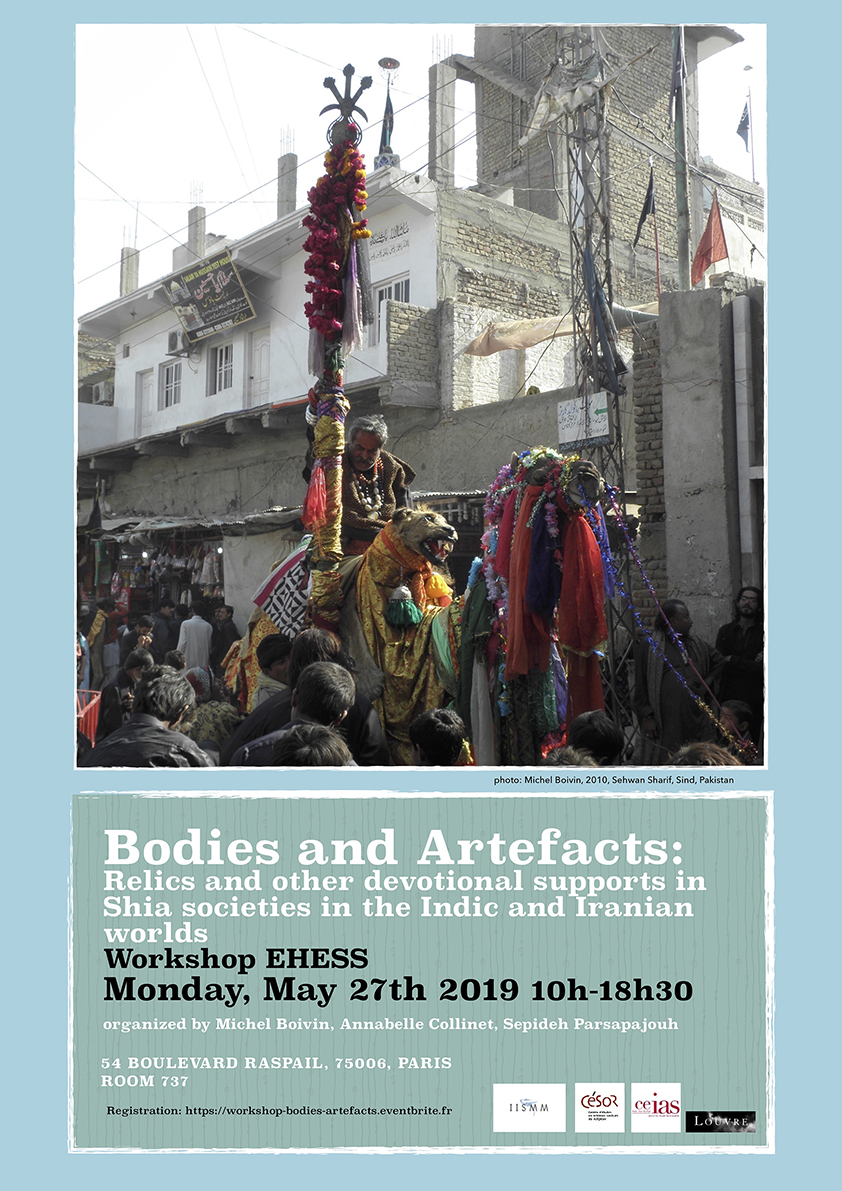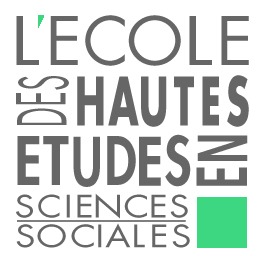Vie scientifique | Journées d'études
Bodies and Artefacts
Relics and other devotional supports in Shia societies in the Indic and Iranian worlds
Salle 737 - 54 bd raspail 75006 Paris
Workshop organisé par le CéSor, le CEIAS et l'IISMM
Programme
10:15 - Welcome Address by CEIAS Director
10:20 - Opening remarks by Michel Boivin, Annabelle Collinet, Sepideh Parsapajouh
10:30 - Karen Ruffle (University of Toronto), EHESS-IISMM Invited Professor
Presence in Absence: The Formation of Reliquary Shiism in Qutub Shahi Hyderabad
In this presentation, I will present relics as indexical forms of remembrance that are powerful manifestations of the “presence in absence” of the Shiʿi saints and Imams. Relics assumed a defining role in shaping a specific form of religious material culture that would find spiritual and political valence among the diverse religious and ethnic polities of the Deccan region of South-Central India during the Qutb Shahi period (ca. 1496-1687 c.e.). I show how the Qutb Shahi sultans encouraged the translation of Shiʿism from an essentially Persianate form into an Indo-Shiʿi idiom through several complex processes of translation and indigenization that transformed the ritual-devotional, literary, architectural, and reliquary material practices into systems that were mutually intelligible to a diversity of Hindu and Muslim communities, alike.
Panel 1 – Manuscript as devotional medium
Chair : Pierre Antoine Fabre, EHESS-CéSor
11:00 - Mounia Chekhab Abudaya, Qatar Museum (Doha)
Pilgrimage certificate as instrument of devotion: example of the Museum of Islamic Art, Doha.
Dated ah 21 Muharram 837 (September 6, 1433 ce), the pilgrimage certificate MS.267.1998, from the Museum of Islamic Art’s collection in Doha, was made for a pilgrim named Sayyid Yusuf bin Sayyid Shihab al-Din Mawara al-Nahri, who undertook the ‘umra. With a length of 666 cm, it features the major Islamic sites, alongside inscriptions from the Qur’an and texts written in Arabic and Persian related to the pilgrimage with the name of the pilgrim and his six witnesses inscribed at the end. This presentation will aim at introducing the scroll’s textual and visual content and in particular its possible use as an object of devotion transporting the viewer to the illustrated sacred places and providing blessings through the physical contact with these images.
11:30 - Zahir Bhalloo, Free University Berlin
"From Sehwân to Masqat. Manuscripts of Sindhi elegies (marsiyâ) among the Lawâtiya of Oman"
Manuscripts containing Shiʻi devotional poetry, in particular Sindhi elegies (marsiyâ) of Sâbit ʻAli Shâh (d. 1800) of Sehwân on the martydom of Husayn (d. 680), were abandonded in the late nineteenth century by the majority of South Asian Khoja followers loyal to the Shia Imami Ismaili spiritual leadership of the Aga Khan. These manuscripts continue to be used, however, as devotional supports by the dissident Twelver Shiʻi Khoja minority known as Lawâtiya that settled in Masqat. In this paper, we will examine how these manuscripts become part of the Khoja satpanth religious tradition in South Asia and their contemporary role among the Lawâtiya of Oman.
12:00 - Olly Akkerman, Free University Berlin
A Neo-Fatimid Library in the Making: The Social Lives of Arabic Manuscripts among the Alawi Bohras of South Asia
The Bohras, a small but vibrant Ismaili community in India that is almost entirely closed to outsiders, hold a secret Arabic manuscript culture, which is enshrined and preserved in royal archives or khizānāt. This paper will investigate the materiality of the khizāna and the social role of its manuscripts. As secret objects that are part of a living manuscript culture, I argue, these manuscripts are central to the identity of the community. Beyond their function as carriers of knowledge, the paper will examine how the books of the khizāna are understood among the Bohras as devotional supports and relics, embodying the direct and unbroken link between the community and the Fatimid past.
Panel 2 - Body and its imprint in devotional rituals
Chair : Rémy Delage, CNRS-CEIAS
14:00 - Daniel de Smet, CNRS-LEM
The foundation of the shrine of al-Husayn’s head in the last decades of Fatimid Egypt: its political and religious implications
One of the last Fatimid caliphs, al-Zâfir, transferred to Cairo the relic of al-Husayn’s head, previously discovered in a miraculous way in Ascalon by the Armenian Fatimid vizier Badr al-Jamâlî. In 1154, eighteen years before Saladin put an end to the Fatimid Empire, the shrine of al-Husayn was officially opened and its devotion was overtly promoted by the regime. Although our sources about this event are scarce, I will try to cast some light on the political and religious implications of the introduction of this Shi’i cult shortly before the final triumph of Sunni Islam in Egypt.
14:30 - Sepideh Parsapajouh, CNRS-CéSor
Some reflections on the geography of corporal relics in Twelver Shia Islam
In Twelver Shia Islam, considering the plurality and multiplication of the venerated figures, the holy places are also innumerable. In this presentation, I focus on the places of devotion that are supposed to contain the bones (corporal relics). I will try to present them in a schematic framework and to discuss some factors (liturgical and emotional) for explaining the importance of some of them, as well as some aspects of their transformations and changes over time.
15:00 - Delphine Ortis, INALCO
The body of the malañg renunciant and his emotions in the devotional rituals of Qalandarī (Sehwan Sharif, Pakistan)
To shed light on the place of the body and emotions in Shia devotional rituals, we will take the renunciant qalandarī or malañg as the subject. Indeed, to progress on the path of Lāl Shahbāz Qalandar, he must put his body and emotions to the test. We wonder what roles do the body and emotions play in this learning of devotion? And what does the transformed body of malañg represent?
15:30 - Annabelle Collinet, Musée du Louvre
Taʿziyeh and dasteh: ʽAlam, costumes and objects of Moharram's devotional theatre and processions in Iran since the Qajar period
During the ceremonies related to the commemoration of the martyrdom of Imam Ḥosayn and his companions, the bodies of actors and believers carry signs that identify the devotional figures celebrated. These objects (armour elements, weapons and sculptures) visually concentrate the story and figure invoked. In the theatre as well as on the banners, they represent the words declaimed, sung or inscribed that relate the drama. The objects worn and carried today are very similar to those identifiable for the Qajar period and are largely inspired for the costumes, from safavid period productions. Made of forged steel and damascened with precious metals, these objects show the durability of models with a strong visual identity and the recurring use of this metal for Shia devotional objects.
Panel 3- Circulation of Material Culture between Shiism and Sufism
Chair: Hélène Zwingelstein, CéSor-EHESS
16:30 - Michel Boivin, CNRS-CEIAS
Body in absence: the Mawla jo qadam in Sindh between Shiism and Sufism
A number of papers have been devoted to the qadam-e rasul in South Asia, or the Prophet Muhammad’s footprints which are visited by devotees. Amazingly, the scholars did not pay attention yet to the qadam-e mowla, namely places where Ali’s footprints can be found, or his horse’s footprints. Such sites can be found in many Sufi sites in the Indus Valley, although they can also be arranged as separate places of devotion, as it is the case in Hyderabad, Sindh. The paper will investigate how the qadam-e mowla can inform us about the interaction between Shiism and Sufism both in Shia and Sufi places of pilgrimage.
17:00 - Hasan Ali Khan, Habib University (Karachi)
The Qalandariyya Sufi Order of Sehwan (Pakistan) (film 35 mn, Hasan Ali Khan, Shabbir Siraj, Nofil Naqvi) in its relationship with Popular Shia devotion
The ethnographic film 'Shahbaz Qalandar' explores the vital role of the Qalandariyya Sufi Order in the city of Sehwan’s religious life, in its relationship with Shia devotional culture. It deals with the diversified contemporary spiritual life and religious practices of the city of Sehwan in Pakistan, including the popular collective ritual at the shrine, the dhammal, and other aspects of Qalandari piety and popular culture, which are solely built around the tragedy of Karbala. The film screening will be preceded by a short talk on the structural commonalties of the Qalandariyya with similar communities in Turkey and Iran, such as the Alevis and Ahl‑i Haqq (Yaresan).
18:00 – General discussion
Les sites du CEIAS
- SAMAJ | The South Asia Multidisciplinary Academic Journal
- CEIAS - Facebook
- CEIAS - Twitter
- CEIAS - Newsletter
- Le Bulletin de la Bibliothèque
- Régionalisme & cosmopolitisme
- DELI | Dictionnaire Encyclopédique des Littératures de l’Inde
- DHARMA | The Domestication of “Hindu” Asceticism and the Religious Making of South and Southeast Asia
- TST | Texts Surrounding Texts
- STARS | Studies in Tamil Studio Archives and Society 1880-1980
- I-SHARE | The Indian Subcontinent’s Shared Sacred Sites
- Sri Lanka et diasporas
- Sindhi Studies Group
- Carnet du Master Études asiatiques
- Master “Asian Studies”
- Social Sciences Winter School in Pondicherry
- Caste, Land and Custom
- Musiques indiennes en terres créoles
 Actualités
Actualités
Écrire dans le monde indo-persan
Vie de l'École -Après un premier workshop en mai 2023 ayant permis aux jeunes chercheurs en études indo-persanes de se rassembler, ce second volet organisé par des doctorants de l'EHESS du Centre d'études sud-asiatiques et himalayennes - Cesah (EHES/CNRS) et du Centre de recherche sur les circul (...)(...)
Devenir juifs : conversions et assertions identitaires en Inde et au Pakistan
 Débat - Mardi 9 mai 2023 - 14:00Présentation« L’an prochain à Jérusalem ! », scande un homme portant une kippa dans une synagogue de Karachi au Pakistan. Ses paroles sont répétées en chœur par les membres de sa communauté, un groupe comptant près de trois cents personnes qui s’autodésignent par (...)(...)
Débat - Mardi 9 mai 2023 - 14:00Présentation« L’an prochain à Jérusalem ! », scande un homme portant une kippa dans une synagogue de Karachi au Pakistan. Ses paroles sont répétées en chœur par les membres de sa communauté, un groupe comptant près de trois cents personnes qui s’autodésignent par (...)(...)
Centre d'Études de l'Inde et de l'Asie du Sud
UMR8564 - CNRS / EHESS
54 boulevard Raspail
75006 Paris, France
Tél. : +33 (0)1 49 54 83 94
Communication :
nadia.guerguadj[at]ehess.fr
Direction :
dir.ceias[at]ehess.fr
La bibliothèque du CEIAS
Maison de l'Asie
22 avenue du Président Wilson 75016 Paris
54 boulevard Raspail
purushartha[at]ehess.fr


